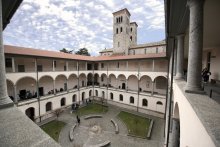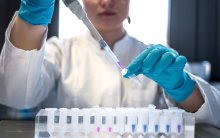Ph.D Course
Restricted access
3 years
Como
Italian
DIPARTIMENTO DI SCIENZA E ALTA TECNOLOGIA
Course description
The main goal of the Graduate School is the development of critical thinking applied to fundamental and applied research in Physics. The experimental and theoretical activities are hosted by the Department of Science and High Technology and are well recognized at international level, with a number of collaborations with leading institutions and key scientists.
Basic Research goes together with collaborative innovation oriented activities with industry, offering Ph.D. candidates the opportunity to grow in a stimulating and challenging environment.
What you need to know
Master’s degree
Enrollment
You can enroll after a public competition for qualifications and examinations.
Posizions: 11
Number of Scholarships: 7 to which is added 1 financed by INAF and 1 financed by contratto ERC
Positions without scholarship: 2
Please see:
Call for admissions
Class attendance
The educational activities (compulsory and optional) are defined annually by the Teaching Board.
Feynman path integrals
I anno: this short lecture series provides a very brief introduction to the Feynman Path Integral approach to quantisation, which represents a completely original and alternative axiomatic basis for quantum theories. While developed within the framework of non-relativistic quantum mechanics, the method is of particular importance (for its clarity and simplicity) in second or field quantisation. However, it finds useful applications in many other areas, as diverse as statistical mechanics and even, for example, financial analysis. Being limited to eight hours of front-on lectures, little attention is paid to mathematical rigour. In other words, a description of the physical basis and significance will be provided, together with some of the interesting applications of the technique of relevance to physics.
Quantum technologies
I anno: the second quantum revolution is unfolding now, exploiting the enormous advancements in our ability to detect and manipulate single quantum objects and triggering the development of the different quantum technologies. The course, after a preliminary introduction to the principles of quantum information, is intended to give an introduction to the different quantum technologies for computing, simulation, communication, metrology, and machine learning, including quantum optics laboratory demonstration of quantum information protocols.
Non-equilibrium statistical physics: kineting roughening and active matter
II anno; classical statistical mechanics describes system at thermodynamic equilibrium. However, a wide range of natural systems, ranging from climate to virtually all living matter, are kept out of equilibrium by external driving and/or fluxes of energy which is constantly absorbed and dissipated through the system.
This course focuses on two prototypical classes of non-equilibrium systems: (i) kinetic roughening of driven interfaces and (ii) active matter.
Kinetic roughening is relevant to the description of many interfacial problems under non-equilibrium conditions (deposition at the solid-gas interface, flame front propagation, wetting, etc.), while active matter is a nonequilibrium paradigma capable of explaining the behavior of many biological systems, from bird flocks to bacteria colonies and cellular migration to cite a few examples.
Non Newtonian aspects of general relativity
I anno: this is a 20 hours course, where some specific aspects of the general relativistic dynamics will be discussed, compared to the analogous mechanisms in Newtonian gravity, when allowed. The main arguments included in the course are:
- Einstein equations and their comparison with Newtonian gravity: time dependence, non harmonicity tensorial character, non linearity;
- Gravitational waves: generation and detection; weak and strong gravitational waves, effective one body formalism;
- Dragging effects and weak and strong gravitomagnetism, with applications to the motion of massive bodies and galaxies.
However, modifications on the program can be considered on demand, in order to adapt the details of the lessons to the specific needs of the students.
Complements of theoretical physics
II anno: this is a 20 hours course, with the aim of presenting some advanced topics in theoretical physics, related with the physics of the standard model and/or general aspects of theoretical physics. The main arguments proposed by the course are:
- Symmetries in quantum field theory: Lie groups, spontaneous symmetry breaking of global symmetries and local symmetries, symmetries in path integral formalism, anomalies;
- Feynman integrals in classical and quantum theories. Methods of computation of the Feynman integrals and related twisted cohomology;
- The geometry of the Standard Model of Particles and possible extensions to grand unification models.
According to the interests of the participating students, it is possible to consider a short introduction to all such arguments, or to develop more deeply one of them if needed.
Fluorescence Methods in molecular biophysics
I anno: biophysics is a subject intrinsically at the interface between hard sciences and life sciences, and constitutes an ideal bridge within these two fascinating universes. In this teaching module the biophysical approach will be outlined, evidencing its specificities and originality with respect to classical biological subjects. The basics of molecular biology will be sketched in “pills”. In so doing, the students will be led to mature a deep comprehension of the intimate relationship between biomolecules structures and their biological function. Subsequently, some considerations will be driven about the peculiar thermodynamics of metabolic reactions. Binding reactions will be modelled in details evidencing their crucial role in metabolic regulation. The main concepts underlying the electronic state transition spectroscopy of molecules in solution will be recalled. The advantages of fluorescence will be discussed and several advanced fluorescence techniques will be presented and applied to the elucidation of binding equilibriums. Particularly, we will focus on time-resolved and fluctuation analyses methods. Further, we will correlate the conformational dynamics of biomolecules with benchmark spectral features, introducing fluorescence resonance energy transfer, both applied on molecular ensembles and at the single molecule level, as a powerful tool to characterize biomolecular structures and interactions. All the above topics will be tackled by relying both on examples extracted from the research experience of the teacher and on critical examination of seminal papers from the historical literature. At the end of the course, the students will inherit a comprehensive panorama of time-correlated single photon counting, fluorescence correlation spectroscopy and single-molecule fluorescence resonance energy transfer. Moreover, they will gain some insight on the molecular mechanisms governing life and on the physical laws on which they are based.
Fundamentals of machine learning
II anno: the course will cover the state-of-the art algorithms and knowledge about the
supervised learing techniques
In particular, those topics will be coveres:
- Introduction to classifications problems and methods. Definition of Training Set, Test Set, Validation and metrics to assess the performances of classifiers;
- Classification based on parametric model;
- Classification based on non-parametric model . Decision Trees, Random Forests and linear classified will be presented with the necessary mathematical background and application in physics/astrophysics;
- Classification with Support Vector Machine and Neural Networks;
- Introduction to Deep Learning techniques and architectures of deep neural networks for.
- Image classifications
In order to fully exploit the lessons and the concepts given in the course plan, an introduction to data preparation, features selections and transformation (e.g. principal component analyss) will also be part of the lectures.
Nota generale a tutti i corsi: gli studenti saranno tenuti a seguire almeno 60 ore di corso all'interno dell'offerta formativa, secondo un piano didattico approvato dal Collegio dei Docenti.
Numerical methods for astrophysics
II anno: the course "Numerical methods for astrophysics" is meant to introduce state-of-the-art numerical modelling techniques employed in astrophysics, and will cover 20 hours. In
detail, the following topics will be covered:
- Newtonian dynamics and the N-body problem (grid-based vs particle-based methods);
- Advanced techniques for computational hydrodynamics: adaptive mesh refinement vs moving-mesh vs mesh-free methods, advantages and limitations;
- High performance computing: code development and optimization.
Time series analysis for astrophysicists
II anno: time series are ubiquitous in astrophysics. This course is aimed at providing PhD students the main capabilities to extract physical information with state-of-the-art statistical inferences from the available datasets. We will refer to real science cases developed in the astrophysical literature, yet the discussed methodologies could be of definite interest to anyone involved in quantitative analysis of data in a temporal (or spatial) sequence in any field of modern physics, economy, engineering and social sciences.
At the end of the course students will be able to:
- Carry out analysis of any statistical problem in a full Bayesian framework;
- Properly model time series to derive meaningful statistical inferences about stationarity;
- Short and long-term memory behavior;
- Deal with data irregular spaced and/or affected bu correlated noise;
- Apply big-data techniques to carry out the analyses of typical large datasets obtained by modern astrophysical facilities.
More specifically the main topics of the course are:
- Time (and spatial) variability in astrophysics
- Time- domain analysis and auto-regressive processes
- Irregular sampling, Lomb Scargle periodograms
- Case studies: ANG variability
- Advanced topics: non-parametric analysis
- Matching filter
- Case study: LIGO/Virgo gravitational wave signals
- Big-data machine learning and intelligent systems for time- series analysis
- Case studies: spatial variability /CMB, large scale structure)
Advanced topics in astrophysics
I anno:
1. Multiscale simulations: incorporating unresolved physical processes in advanced numerical simulations.
2. Search for periodicity in astrophysical time-series.
3. Structure and Physics of the Milky Way.
4. Atmospheric escape in exoplanets.
5. Machine Learning in Astrophysics.
Advanced astrophysical fluid dynamics
II anno:
- Rotating equilibria and thick discs: barotropic equilibria and Taylor-Proudman theorem, baroclinic equilibria, Solberg-Hoiland stability criterion
- Accretion discs: inviscid thin disc, viscous evolution of a thin disc and spreading of a thin ring, steady-state viscous thin discs, angular momentum transport, Shakura-Sunyaev alpha-disc “standard” model, emitted spectrum, the Eddington limit, angular momentum transport in discs
- Effects of rotation on waves, epicyclic frequency and Lindblad resonances, density waves in discs, Toomre instability, Papaloizou-Pringle instability
Low-noise measurements and feedback: a laboratory
I anno: Freshman statistics tells you that if you want data with lower noise, you can always average for longer. Sometimes this would take an unfeasible amount of time, other times you might realize that noise increases with the duration of the measurement - the infamous experimental drifts - and more averaging is detrimental.
In this hands-on course we will introduce how to characterize the time dependence of noise using the noise power spectral density, and how to identify the best averaging time before drifts kill the measurement through the Allan deviation. We will introduce two methods for increasing signal-to-noise ratio: lock-in detection, which works well when the property to be measured can be switched on and off periodically, and closed-loop feedback control, to stabilize the experimental apparatus and reduce drifts in the first place.
The course is well suited to experimentalists and theoreticians alike: we will see techniques at work in any mobile phone and modern kitchen oven, that can be implemented in many experimental setting but also used to understand how gravitational waves are detected.
Laser-Driven Radiation Sources: Science, Technology and Applications
II anno: This short course introduces students to the technological aspects and applications of laser-driven sources of radiation, one of the most active areas of research in laser physics today. The course begins with a brief introduction to ultrafast lasers, followed by an overview of the science, technology, impact, and applications of state-of-the-art secondary sources. These include parametric amplifiers (mid-infrared sources), optical rectification or photoconductive switching (THz sources), and non-perturbative light-matter interactions (high-order harmonic generation).
Fundamentals and Applications of Optical Metrology
II anno: This short course introduces students to the basic concepts of optical metrology and provides an overview of the current state-of-the-art for some of its most advanced and widespread applications. The course begins with an introduction to the theoretical aspects of optical metrology and the physical mechanisms underpinning its applications. It then analyzes examples of transformative metrological applications, such as interferometry (empowering the observation of phenomena like gravitational waves), spectroscopy (e.g., time-resolved spectroscopy with unparalleled sensitivity), and dual-comb spectroscopy (used e.g., astrophysical observations).
Advanced Concepts of Light-matter Interaction and Their Applications
I anno: This short course introduces students to the basic concepts of light-matter interactions and their applications. It begins with an introduction to laser physics and the different regimes of light-matter interaction driven by intense laser fields. The course then focuses on key applications of lasers, such as micromachining (cutting, drilling, and machining of transparent materials), medical applications (e.g., eye surgery), and applications to astrophysics (spectroscopy and interferometry).
For information
Dipartimento di Scienza e alta tecnologia – DISAT
Università degli Studi dell'Insubria
via Valleggio, 11 - 22100 Como
Coordinator: Prof. Giuliano Benenti
E-mail: giuliano.benenti@uninsubria.it





